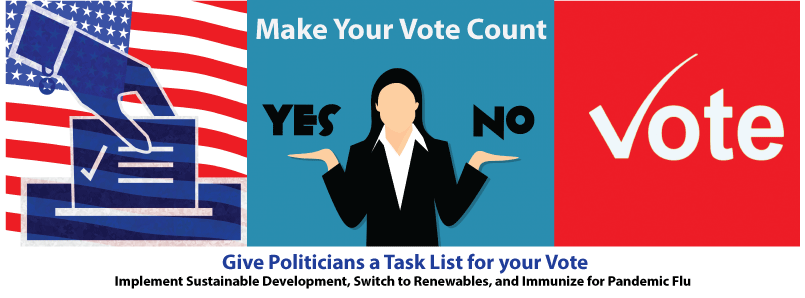Vote for politicians who will switch the energy system to renewable energy, implement sustainable development, and immunize the population for pandemic influenza. This page gives you the essential, practical things we all can do to move toward living sustainably, and to switch the world’s energy system to renewables. It’s a bucket list of things we need to accomplish—before we die (from unmitigated natural climate change catastrophes)
Why must we act with a sense of urgency? Because the United Nations via the Intergovernmental Panel on Climate Change (IPCC) categorically dismissed or omitted natural climate change in its climate change theory, climate forecasts and climate risks assessments provided to governments. The IPCC also failed to prioritize the message that we only have decades of proven oil and gas reserves left.
This means our governments do not have mitigation plans for catastrophic natural climate change risks posed during this grand solar minimum. Likewise, governments and citizens don’t have the correct sense of urgency required to switch the world’s energy system to renwables, while supporting developing nations. In addition, our governments, the vaccine industry, and the WHO led global influenza plan (“stakeholders”)have failed to upgrade the archaic pandemic flu vaccine technology since the 2009 swine flu pandemic and its vaccine supply debacle. These stakeholders gave the world an extra influenza-B strain in the seasonal flu vaccine, while leaving the world’s population unnecessarily defenceless against pandemic influenza. (Chapter 14)
If your government and municipal leaders are not talking about these issues and the following key tasks at election time, then don’t vote for them. Find someone to vote for who will get these jobs done for your community, your nation, and today’s youth who will inherit our resource depleted planet in tomorrow’s ice age world.
What follows is a condensation of all of the best practice ideas from Section 3 of “Revolution: Ice Age Re-Entry” organized into a bucket list—the things we must do to switch over energy systems to renewables, to live sustainably, to immunize the population against pandemic influenza, and to prepare for the world that today’s youth will inherit.
What it means to live sustainably: that we use all energy, water, food, and other resources sparingly, efficiently and equitably, maximizing residual resource and energy recovery, while generating a minimal amount of waste and pollution. This philosophy should permeate everything we do at home, at work, and when we travel, and be the norm for our urban, rural, and national ways of life.
Task List for Political and Municipal Leaders (No Action = No Vote)
Pre-pandemic influenza immunization: Change the archaic pandemic flu vaccine supply paradigm to prevent needless human culling during a pandemic. Implement a pre-pandemic influenza vaccine campaign to protect against highly pathogenic avian H7N9 and H5N1 influenza strains (in the first instance). In the longer term ensure the vaccine industry creates a pre-pandemic flu vaccine for interpandemic use composed of multiple H2, H5, H7, and H9 influenza-A strains (i.e., the Prevnar or Gardasil-equivalent for pandemic flu). Oil-in-water adjuvants will be required to upgrade the vaccine technology. Make this vaccine’s use voluntary, and ensure the developing nations and developed nations alike are offered the vaccine. (Chapter 14)
Financing: Implement a global carbon tax priced at a minimum of $30 per ton. Deploy more renewable energy feed-in-tariffs (i.e., premium-priced electricity supply contracts) to incentivize the installation of more renewable energy capacity. Partially redirect fuel subsidies to help the poor gain access to affordable renewable energy systems. Change pension fund regulations to better enable pension funds to invest in renewable energy infrastructure and sustainable community development projects (promote public-private partnerships). Accelerate the Paris Agreement’s $100 billion annual financing and start project investments. (Chapter 8)
Renewable Energy and Energy Efficiencies: Invest in massive quantities of renewable energy (centralized and decentralized). This will take the form of more efficient hydropower and pumped-storage hydropower, on/off-shore wind, solar PV and concentrating solar power, geothermal, and energy from biomass waste. Install renewable energy heating and ground-source heat exchange systems wherever possible. Invest in efficient fossil fuel co-generation and heat recovery systems. Implement massive reforestation projects (i.e., for energy and groundwater recharge). Technology R&D: Invest in high-yield (i.e., fusion, fission, and the free energy concept-promise) and alternative energy systems. (Chapter 9)
Upgrade the Electric Grid: Install regional super-grids and local smart grids, massive quantities of high voltage direct current transmission interconnections, and gigawatt battery storage (i.e., to improve energy system resilience). (Chapter 9)
Transportation: Incentivize fuel efficiency and vehicle weight reductions, as well as biomass-waste derived biofuel and synthetic fuel conversions. Invest in electric road, rail, and public transportation systems. Avoid biofuels made from irrigation-dependent crops. (Chapter 9)
Sustainable Water Supply: Ensure that integrated water resource management becomes the regional and municipality norm. Establish transboundary river agreements and full economic pricing of water. Implement groundwater recharge by reconnecting rivers to floodplains, increasing artificial recharging of groundwater, and undertaking massive reforestation projects. Invest in massive quantities of renewable energy desalination systems and bulk water pipelines. Implement policies and pricing to ensure agriculture and industry conserve and efficiently use water resources. Fix the leaky pipes. (Chapter 10)
Food supply: Prepare large-scale agriculture for climate switching with cold- and drought- adapted crops and methods ready to be used in a climate crisis. Ensure agriculture is sustainable (i.e., reduce yield gaps, reduce deforestation, minimize chemicals and waste fertilizer). Support smallholder farmers with sustainable farming methods and access to climate-adapted seeds. Reduce food waste from field to plate. Decentralize food supply for towns and cities by implementing urban and peri-urban agriculture. Invest in urban high-tech indoor farming. Develop sustainable aquaculture (urban and rural). Support home food production. Promote urban soil-less food production (i.e., hydroponics, aquaponics, aeroponics). (Chapter 11-12)
Emergency food stockpiles and climate-independent food supply: Reassess food stockpiles. Ensure municipal seed banks are well stocked (no sterile seeds). Invest in peri-urban industrialized greenhouses, high-tech indoor urban farming, and bulk-scale single-cell protein manufacture. Invest in R&D for low-cost, renewable energy LED lighting systems for crop growing (for both commercial and home use). (Chapter 12)



Recent Comments